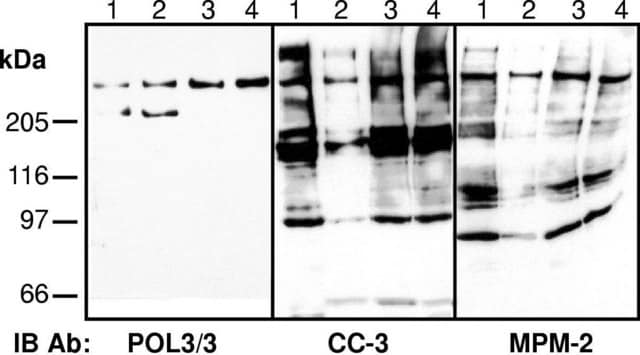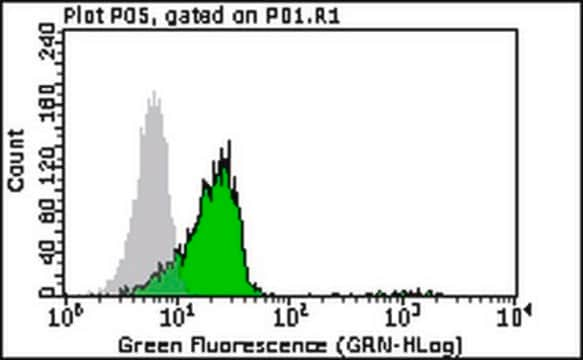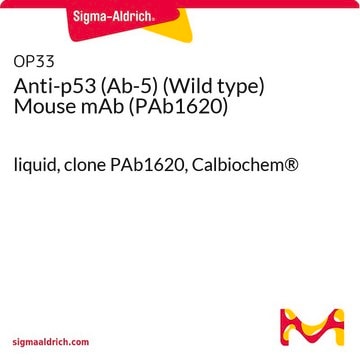MABC1786
Anti-Glypican-2 Antibody, clone CT3
Sinonimo/i:
GPC2
About This Item
Prodotti consigliati
Origine biologica
mouse
Livello qualitativo
Forma dell’anticorpo
purified antibody
Tipo di anticorpo
primary antibodies
Clone
CT3, monoclonal
PM
calculated mol wt 62.83 kDa
observed mol wt ~56 kDa
Purificato mediante
using protein G
Reattività contro le specie
human
Confezionamento
antibody small pack of 100
tecniche
ELISA: suitable
flow cytometry: suitable
immunohistochemistry: suitable
inhibition assay: suitable
western blot: suitable
Isotipo
IgG1κ
Sequenza dell’epitopo
C-terminal
N° accesso ID proteina
N° accesso UniProt
Temperatura di conservazione
-10 to -25°C
Informazioni sul gene
human ... GPC2(221914)
Specificità
Immunogeno
Applicazioni
Evaluated by Western Blotting in SH-SY5Y cell lysate.
Western Blotting Analysis: A 1:500 dilution of this antibody detected Glypican-2 in SH-SY5Y cell lysate.
Tested Applications
Western Blotting Analysis: A 1:500 dilution from a representative lot detected Glypican-2 in IMR-32 cell lysate.
Immunohistochemistry Applications: A representative lot detected Glypican-2 in Immunohistochemistry applications (Li, N., et al. (2021). Cell Rep Med. 2(6): 100297; Li, N., et al. (2020). J Histochem Cytochem. 68(12): 841-862).
ELISA: A representative lot detected Glypican-2 in ELISA applications (Li, N., et al. (2021). Cell Rep Med. 2(6): 100297).
Flow Cytometry Analysis: A representative lot detected Glypican-2 in Flow Cytometry applications (Li, N., et al. (2021). Cell Rep Med. 2(6): 100297; Li, N., et al. (2020). J Histochem Cytochem. 68(12): 841-862).
Western Blotting Analysis: A representative lot detected Glypican-2 in Western Blotting applications (Li, N., et al. (2021). Cell Rep Med. 2(6):100297).
Note: Actual optimal working dilutions must be determined by end user as specimens, and experimental conditions may vary with the end user.
Descrizione del bersaglio
Stato fisico
Ricostituzione
Stoccaggio e stabilità
Altre note
Esclusione di responsabilità
Not finding the right product?
Try our Motore di ricerca dei prodotti.
Codice della classe di stoccaggio
12 - Non Combustible Liquids
Classe di pericolosità dell'acqua (WGK)
WGK 2
Punto d’infiammabilità (°F)
Not applicable
Punto d’infiammabilità (°C)
Not applicable
Certificati d'analisi (COA)
Cerca il Certificati d'analisi (COA) digitando il numero di lotto/batch corrispondente. I numeri di lotto o di batch sono stampati sull'etichetta dei prodotti dopo la parola ‘Lotto’ o ‘Batch’.
Possiedi già questo prodotto?
I documenti relativi ai prodotti acquistati recentemente sono disponibili nell’Archivio dei documenti.
Il team dei nostri ricercatori vanta grande esperienza in tutte le aree della ricerca quali Life Science, scienza dei materiali, sintesi chimica, cromatografia, discipline analitiche, ecc..
Contatta l'Assistenza Tecnica.








